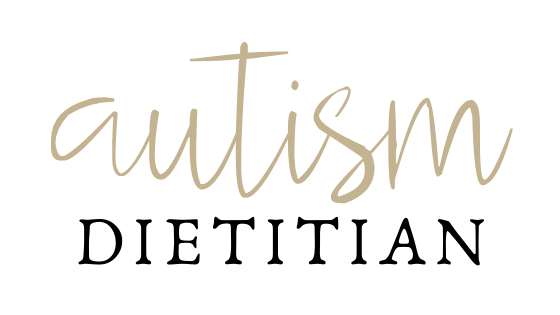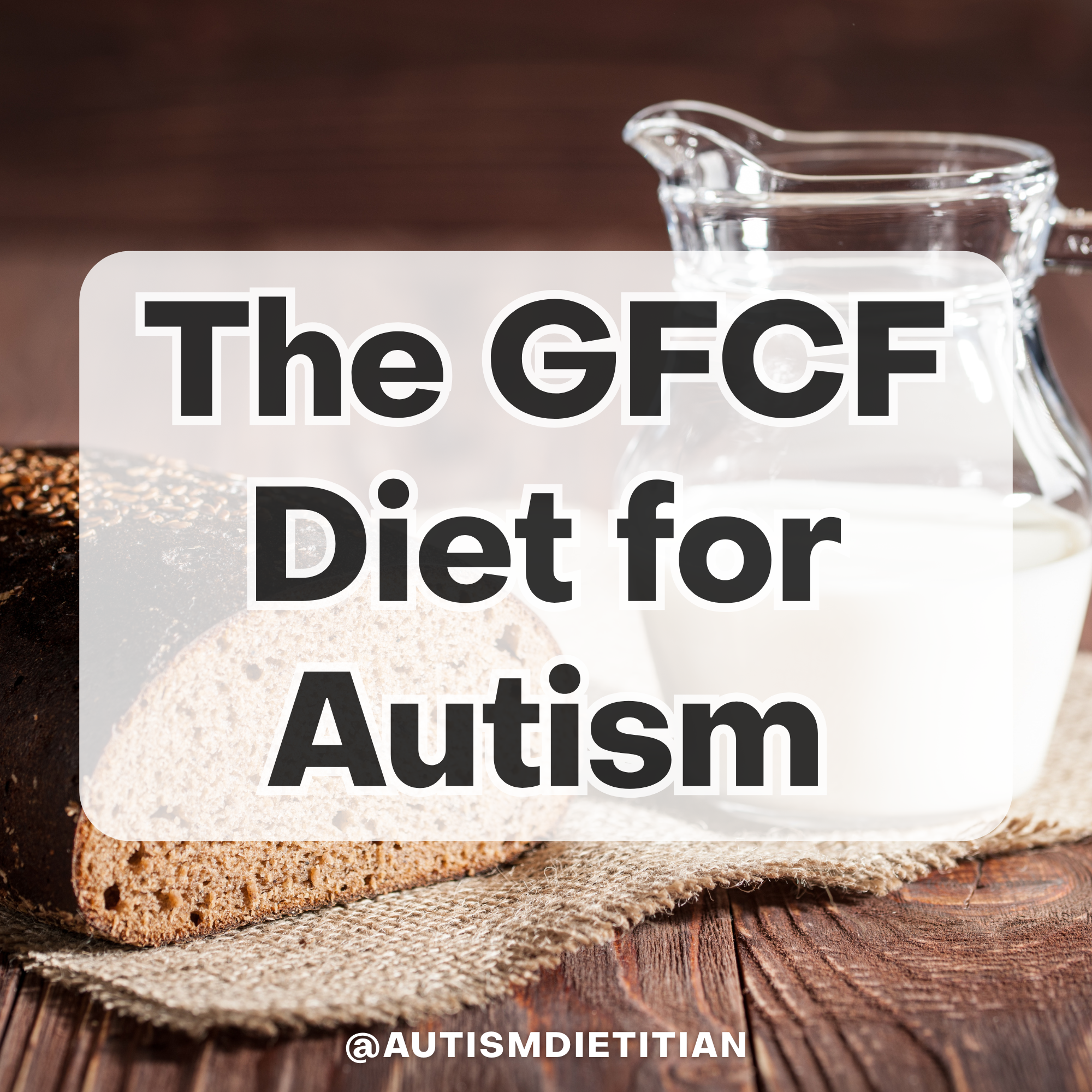The GFCF Diet for Autism
You may have heard about the GFCF diet for autism - it’s been around for a while, and many have differing opinions on its effectiveness. Some have labeled it a fad diet, while others swear by its effectiveness. While the scientific evidence available is relatively limited, there have been studies that have shown its benefit in children with autism. [1,2]. In addition, those in clinical practice (and many parents) have seen success with using this diet for autism. So, let’s jump in and get a closer look at the GFCF diet, and look at some of the reasons many find success with it.
What is the GFCF Diet?
The GFCF (gluten-free, casein-free) diet is a diet for autism that avoids all gluten (found in wheat, barley, and rye) and casein (found in dairy). Many parents of children with autism report that it helps with positive changes in behavior, sleep, and speech.
The thought behind the diet is that it works by eliminating 2 proteins that children with autism may be especially sensitive to - gluten and casein. These proteins are more difficult to digest, and in the case of gluten, can actually damage the gut and lead to “leaky gut”.[3] When the gut is damaged, small parts of the proteins enter the bloodstream and can impact the brain, which can lead to many of the symptoms we often see with autism.[4] For more on the Gut-Brain Connection, this post provides a more in-depth explanation.
Gluten and casein can also affect folate metabolism, causing a deficiency. Some children with autism have trouble metabolizing folate and are already deficient. Having gluten and casein may further exacerbate folate deficiency, which affects brain development. This happens in a couple of different ways:
Casein can block folate receptors, not allowing it to enter spinal fluid. [5].
Gluten-containing packaged foods are frequently fortified with synthetic folic acid. Many children with autism have a genetic variation that makes it difficult for their bodies to use folic acid, especially in the synthetic form. The folic acid then builds up in the bloodstream, and can block folate receptors.
Will the GFCF Diet for Autism Help My Child?
While there is no guarantee you will see positive changes in your child, the good news is the diet does not have major risks or side effects, so it is a relatively safe change to make - and for many, it’s worth a try.
Who Shouldn’t Follow the GFCF Diet?
Although the diet is safe in general, if your child has a very restrictive diet and primarily eats foods containing gluten and dairy, it would be best to work on expanding your child’s diet before trying the GFCF diet. Extremely picky eaters may benefit from working with a dietitian or feeding specialist to expand their diet so they’re able to eat the foods included in the GFCF diet.
Gluten-containing foods, like wheat, have fiber that is great for gut health, so it's important to ensure your child’s diet still contains other high-fiber whole grains and vegetables. Since dairy is a good source of calcium, also making an effort to ensure your diet has plant-based sources of calcium, like broccoli and leafy greens is important. If your child doesn’t frequently eat veggies that provide calcium, a supplement may be needed.
How to Start a GFCF Diet for Autism
The key to following a gluten-free, casein-free diet is to identify sources of gluten and casein in foods your child eats and to fully eliminate all sources from the diet. This can be done gradually, or all at once. The diet is most effective when all sources of gluten and dairy are eliminated, so the goal isn’t to just reduce gluten and dairy - it needs to be fully eliminated for a period of time, usually at least 2-3 weeks, to see results.
Eliminating Gluten
Here are some gluten sources that should be avoided:
Grains:
Wheat (all types)
Barley
Rye
Semolina
Spelt
Bulgur
Couscous
Anything “malt” or “malted”
Oats not labeled gluten-free
Any flour from above sources
Bread, Cereal, Pasta, Snacks
Wheat bread (whole grain wheat, white bread, rye, barley, pumpernickel)
Cereal bars
Tortillas that aren’t labeled gluten-free
Granola and granola bars that aren’t labeled gluten-free
Durum or semolina pasta
Egg noodles
Wheat crackers
Any cracker not labeled gluten-free
Conventional baked goods and pastries
Other
Soy sauce/tamari
Gravy mixes, seasonings
Malt or “malted” grains
Malt vinegar
Modified starch
Certain candies (licorice)
Eliminating Casein
Here are casein sources that should be avoided:
Milk
Cow milk
Goat milk
Sheep milk
Other mammal milk
Other Dairy Products
Yogurt
Cheese
Sour cream
Butter
Ice cream
Milk chocolate
Creams
Other
Most pastries, like cakes, cupcakes, and cookies
Crackers and chips with added milk flavoring (goldfish, sour cream chips)
Dairy-based sauces and dressings
What CAN My Child Eat?
While there are many foods that are off-limits on a GFCF diet for autism, there is also an abundant number of foods that can be included, so let’s take a look at some of the things your child can enjoy while eating gluten-free and casein-free.
Grains
Rice
Oats that are labeled gluten-free
Amaranth
Buckwheat
Chickpea
Millet
Quinoa
Corn
Tapioca
Any flour from the above sources
Bread, Cereal, Pasta, Snacks
Breads that are labeled gluten-free
Tortillas that are labeled gluten-free
Gluten-free muesli
Puffed rice, quinoa, kamut, or corn cereals and granolas
Rice, quinoa, corn, or chickpea pasta
Rice and corn cakes
Gluten-free products and mixes (check labels for dairy)
Gluten-free baked goods and pastries
Milk
Almond milk
Coconut milk
Cashew milk
Rice milk
Oat milk
Pea milk
Other Non-dairy Alternatives
Plant-based yogurt (made from almond, cashew, or coconut)
Plant-based cheese and sour cream
Dairy-free butter
Dairy-free ice cream
Eggs are not dairy and can be eaten
Other
Gluten-free soy sauce, tamari, or coconut aminos
Fresh/dried herbs and spices that are certified GF
Apple cider vinegar
Ketchup and mustard
GF crackers and chips with no added dairy ingredients
Dairy-free chocolate
GFCF sauces and dressings
GFCF pastries and baked goods
Hidden Sources of Gluten and Casein
There are some places gluten and dairy may be lurking without you realizing it. Here are just a few to be aware of:
Vitamins
Medications
Chapstick, lip gloss
Ingredients used in processed foods like autolyzed yeast, hydrolyzed vegetable protein, caramel color, modified food starch, sodium caseinate, whey, lactose
My Favorite Gluten-Free Brands:
Simple Mills - Crackers, muffin mixes, bread mixes, cake mixes, cookies, crackers, bars
Bob’s Red Mill - Gluten-free flours, baking mixes, bars, oats, cereals, granola
Schar - Gluten-free bread and pizza crust
Glutino - Pretzels, crackers
Udi’s - Breads, buns, muffins, frozen meals (not all of their products are casein-free)
Jovial - Pasta
Enjoy Life - Cookies, bars, breakfast
Vans - Crackers, frozen waffles, bars
My Favorite Casein-Free Brands:
Malk - Plant-based milk
Ripple - Plant-based milk, half n half, ice cream
Three Trees - Plant-based milk
Kite Hill - Plant-based yogurt, cream cheese, ricotta, sour cream, ravioli, dip
Miyoko’s - Plant-based butter, cheese, cream cheese
Forager - Plant-based milk, butter, yogurt, sour cream
GFCF Cookbooks
When you’re getting started on a GFCF diet, it helps to have some solid recipes to make. Here a few cookbooks to get you started!
Eating Out with GFCF Diet
Finding restaurant options while following a GFCF diet can be challenging, but it is something that can be done! Here are a few tips for eating out while you’re avoiding gluten and dairy:
Check online for gluten-free menu options before you go. Nothing is worse than sitting down to eat, looking at the menu, and realizing there is very little your child can safely eat. Most restaurants have websites where you can view their menu, and some restaurants have gluten-free menus. If you can’t tell by looking at their website, give them a call and ask about gluten-free and dairy-free foods. There are many restaurants that have GFCF friendly menus, so see what is available in your area.
Be prepared to be detailed in your order. You’ll have to specify to leave off anything that has cheese, request that it not be cooked in butter, or hold the bread. Try to be prepared and look at anything listed in the description that sounds like gluten or dairy.
Choose a restaurant that caters to gluten-free and dairy-free meals. It makes it a lot easier if you go somewhere that has gluten-free buns for their burgers, or has an allergy-friendly menu, because they’ll be much more knowledgeable and accommodating. Some pizza restaurants also offer gluten-free crust and dairy-free cheese, which makes eating out much easier!
How to Transition to a Gluten-free, Casein-free Diet
There’s no one-size-fits-all approach to implementing this diet, so it really depends on what works best for you and your child. Some kids with autism really struggle with big changes, so gradually replacing their gluten and casein foods with alternatives may work best. Other kids may do better with an everything-at-once approach. You know your child and your family best, so choose the approach that is most likely to be successful for you.
What about Soy? And Corn?
Many children with autism who are sensitive to gluten and casein have sensitivities to soy and corn as well. The protein structure of soy is quite similar to gluten and casein, so it can lead to many of the same challenges in kids with autism. If you suspect your child is sensitive to soy, corn, or any other foods, it makes sense to eliminate them for a trial period of 2-3 weeks, and observe your child for any noticeable changes. If you don’t notice any differences, you could gradually reintroduce them and once again, observe your child for any noticeable changes. If your child has a negative response to them, you could try eliminating them for a longer period of time. This process of elimination and reintroduction can be tricky, so it’s best to do it with the help of a dietitian.
The Bottom Line
Over the years, many families of children with autism have seen success and progress with a gluten-free, casein-free diet. Although it can be a process to implement it and get your child used to eating alternatives to some of their favorite foods, many families feel the struggle is worth it. Only you can decide if it’s right for you!
👋 Need help with your child’s nutrition and Selective eating?
Join the Nourishing Autism Collective for expert guidance, a supportive community, and sensory-friendly strategies that actually work.
FOLLOW @AUTISMDIETITIAN ON INSTAGRAM FOR DAILY POSTS!
Blog written by Kalee Lundmark, MS, RDN, IFNCP
Kalee Lundmark is a Registered Dietitian Nutritionist who enjoys sharing her passion for nutrition with other moms. She has spent the last 20 years working with children to optimize their nutrition and help them overcome feeding challenges.
References:
[1] Ghalichi F, Ghaemmaghami J, Malek A, Ostadrahimi A. Effect of gluten free diet on gastrointestinal and behavioral indices for children with autism spectrum disorders: a randomized clinical trial. World J Pediatr. 2016;12(4):436-442.
[2] Adams JB, Audhya T, Geis E, et al. Comprehensive Nutritional and Dietary Intervention for Autism Spectrum Disorder-A Randomized, Controlled 12-Month Trial. Nutrients. 2018;10(3).
[3] Navarro F, Pearson DA, Fatheree N, Mansour R, Hashmi SS, Rhoads JM. Are 'leaky gut' and behavior associated with gluten and dairy containing diet in children with autism spectrum disorders?. Nutr Neurosci. 2015;18(4):177-85.
[4] Fowlie G, Cohen N, Ming X. The Perturbance of Microbiome and Gut-Brain Axis in Autism Spectrum Disorders. Int J Mol Sci. 2018;19(8).
[5] Ramaekers VT, Sequeira JM, Blau N, Quadros EV. A milk-free diet downregulates folate receptor autoimmunity in cerebral folate deficiency syndrome. Dev Med Child Neurol. 2008;50(5):346-52.












